Abstract
1. Several lines of evidence suggest that both volatile and intravenous anaesthetics may interfere with the synthesis and release of endothelium-derived vasoactive factors. We have investigated the effects of three different barbiturates on the release of nitric oxide (NO) and endothelium-derived hyperpolarizing factor (EDHF) in phenylephrine (1 microM)-preconstricted, endothelium-intact ring segments of the rabbit carotid artery. The segments were pretreated with the cyclo-oxygenase inhibitor, diclofenac (1 microM), to prevent the formation of vasoactive prostanoids, such as prostacyclin (PGI2). 2. Acetylcholine (ACh) elicited a concentration-dependent relaxation (EC50 0.15 microM) in control segments which was not significantly different from the relaxant responses of segments pretreated with methohexitone (0.03-0.3 mM), phenobarbitone (0.1-0.3 mM) or thiopentone (0.1-0.3 mM). 3. Inhibition of NO synthesis with NG-nitro-L-arginine (0.1 mM) significantly reduced the maximum relaxant response to ACh from 96 to 40%. This NO/PGI2-independent relaxation appeared to be mediated by the release of EDHF, since it was strongly diminished in the presence of the K+Ca inhibitors, tetrabutylammonium (1-3 mM) and charybdotoxin (10 nM), following preconstriction with potassium calcium (40 mM) or removal of the endothelium. Thiopentone or methohexitone markedly attenuated the EDHF-mediated relaxant response to ACh, while phenobarbitone had no effect. The endothelium-independent relaxation elicited by sodium nitroprusside (0.01-10 microM), on the other hand, was only marginally affected by these anaesthetics. 4. The cytochrome P450 inhibitor, clotrimazole (3-100 microM), mimicked the inhibitory effect of thiopentone and methohexitone on the NO/PGI2-independent relaxant response to ACh.(ABSTRACT TRUNCATED AT 250 WORDS)
Full text
PDF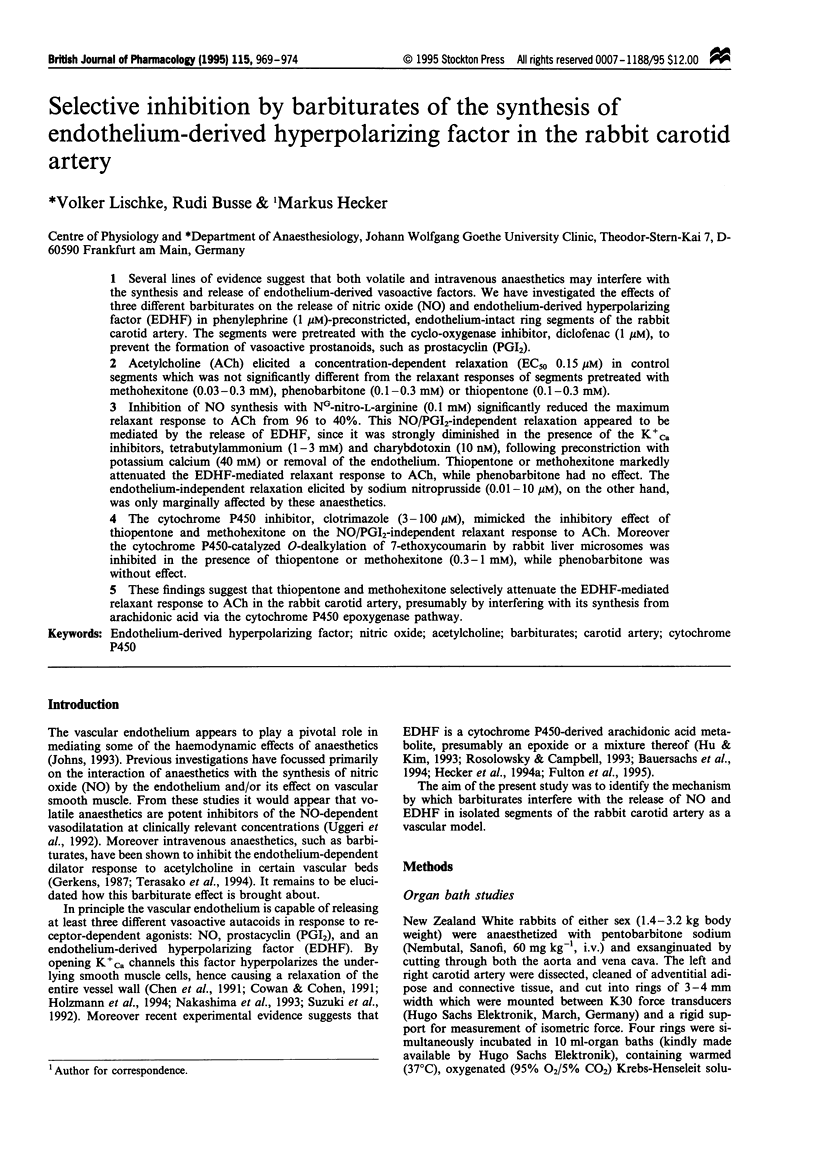
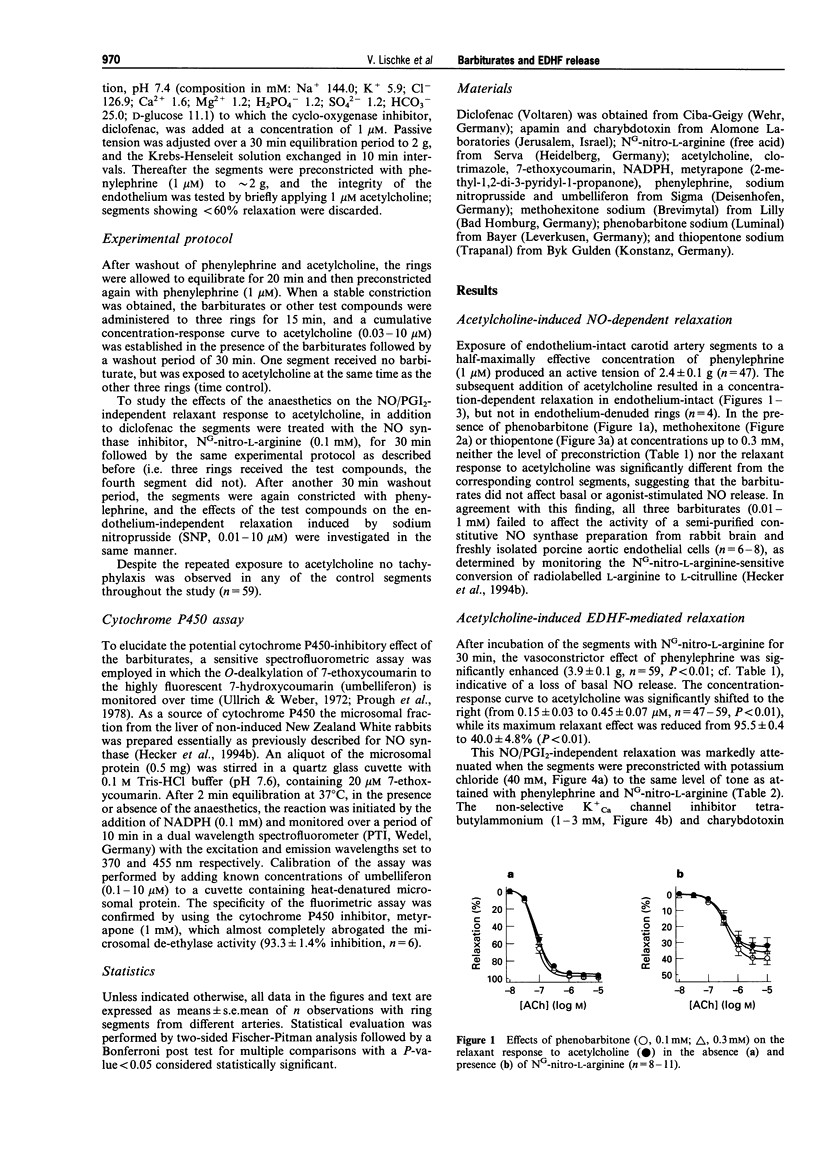
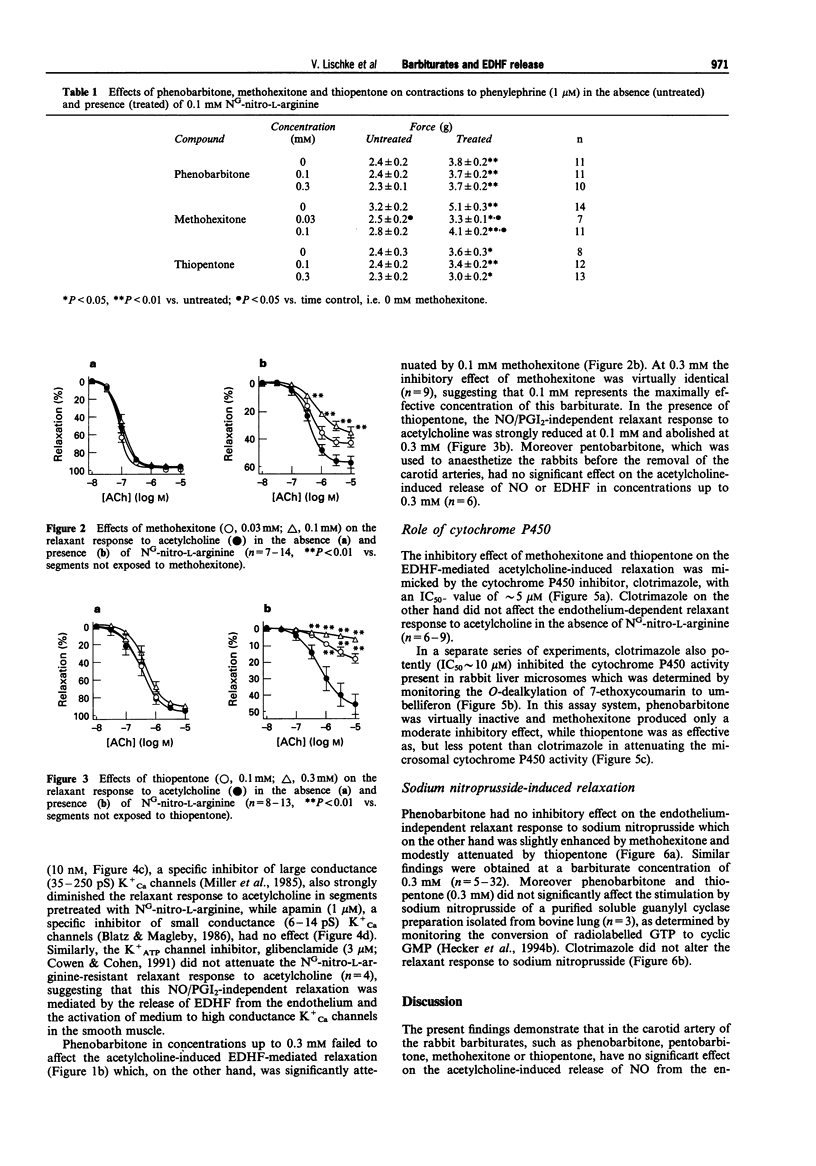
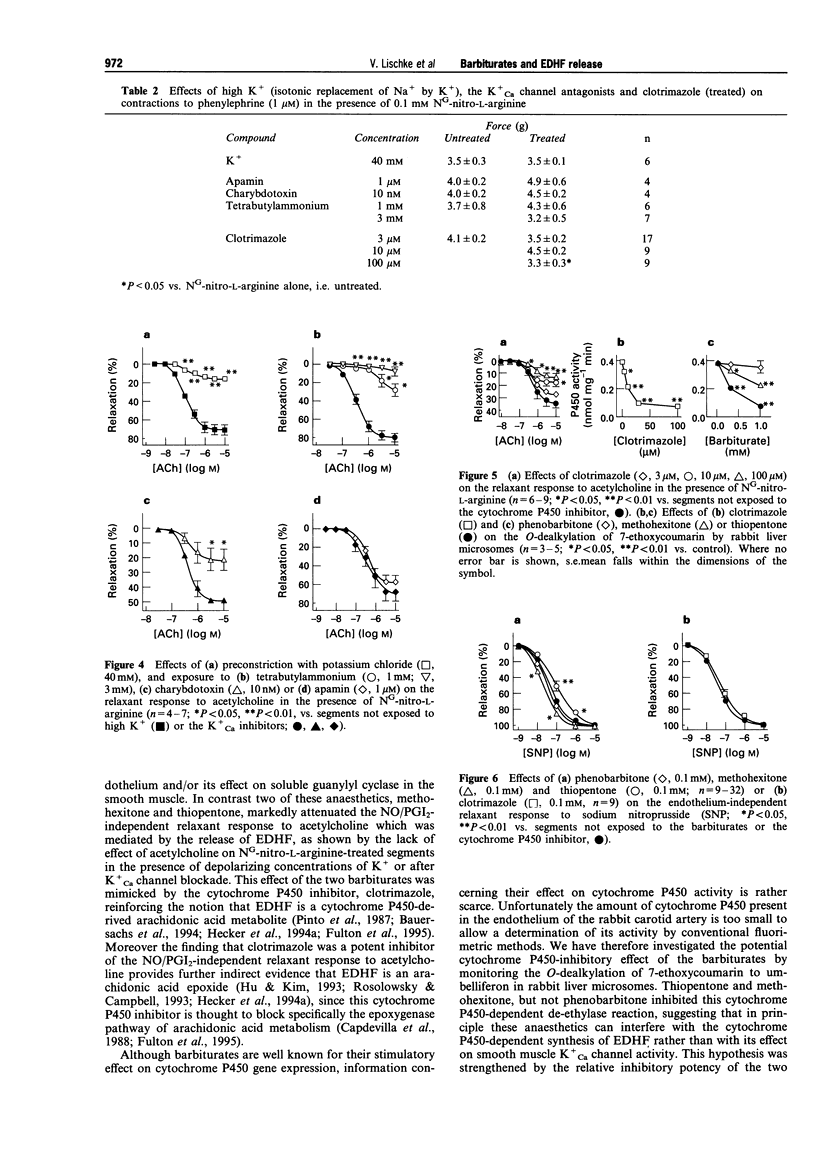
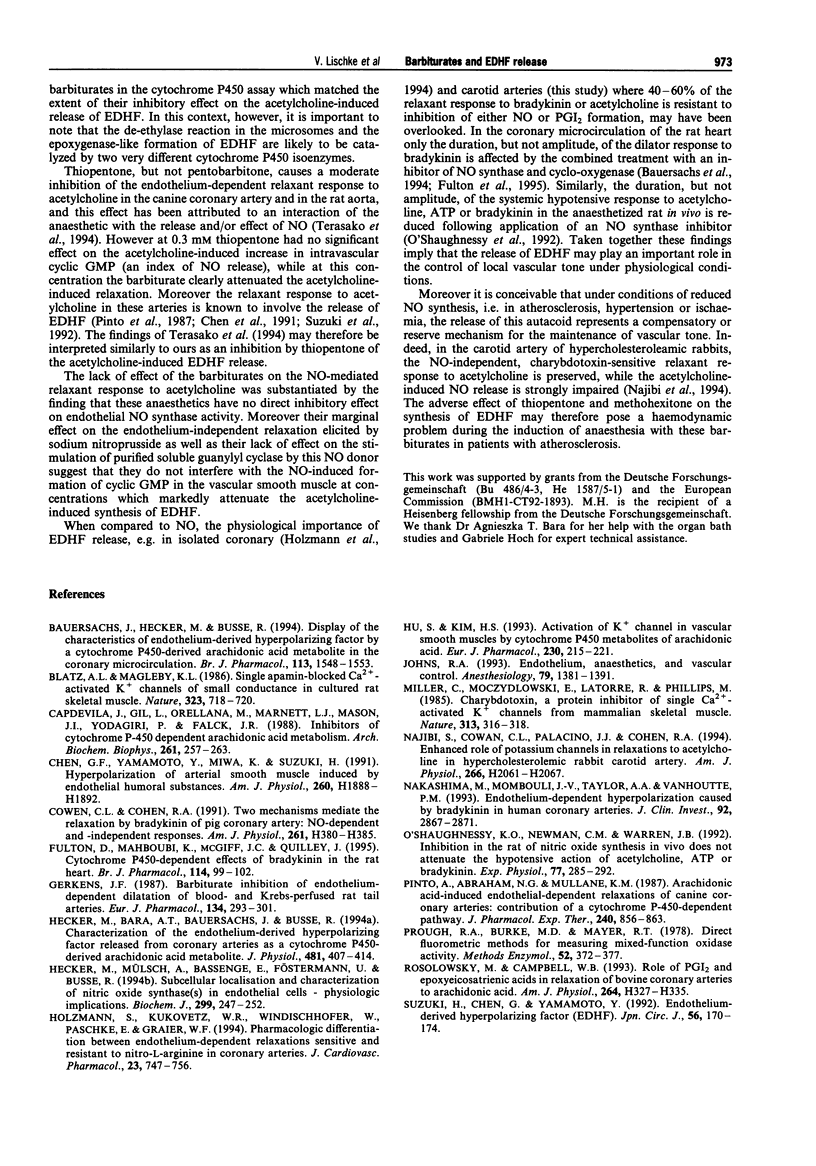
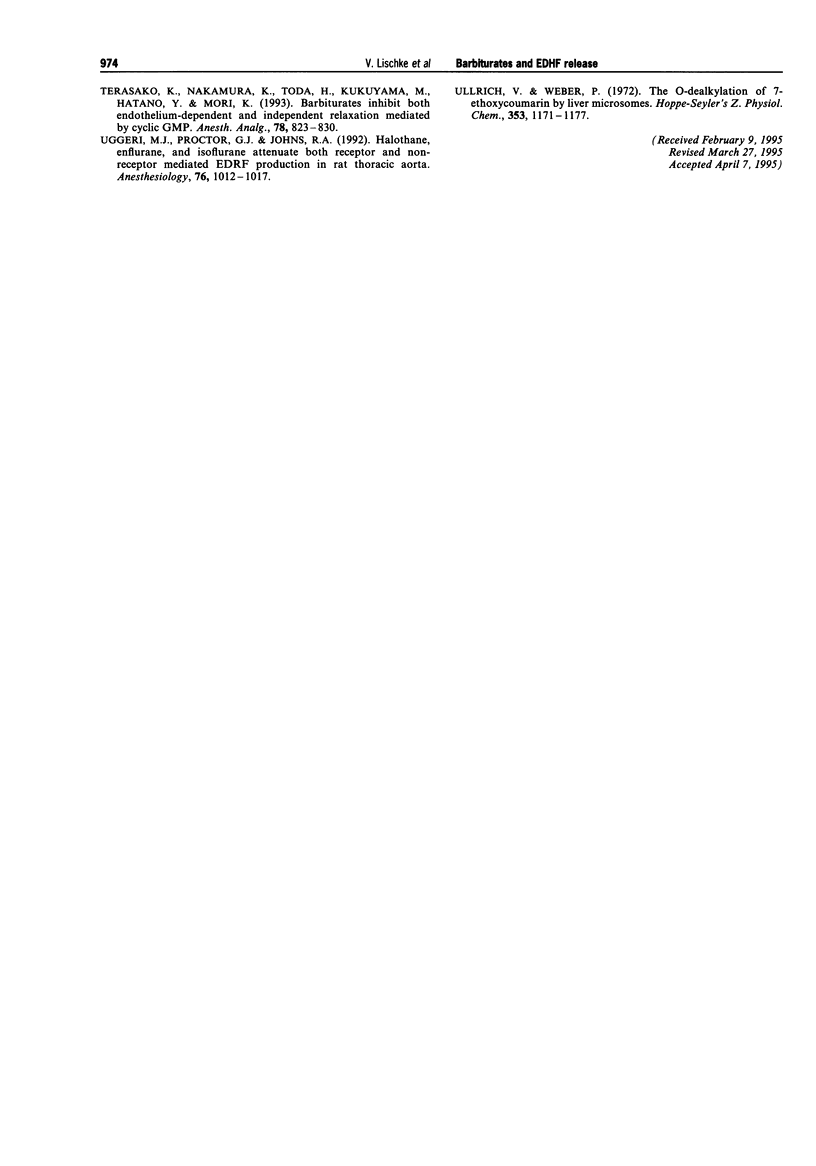
Selected References
These references are in PubMed. This may not be the complete list of references from this article.
- Bauersachs J., Hecker M., Busse R. Display of the characteristics of endothelium-derived hyperpolarizing factor by a cytochrome P450-derived arachidonic acid metabolite in the coronary microcirculation. Br J Pharmacol. 1994 Dec;113(4):1548–1553. doi: 10.1111/j.1476-5381.1994.tb17172.x. [DOI] [PMC free article] [PubMed] [Google Scholar]
- Blatz A. L., Magleby K. L. Single apamin-blocked Ca-activated K+ channels of small conductance in cultured rat skeletal muscle. Nature. 1986 Oct 23;323(6090):718–720. doi: 10.1038/323718a0. [DOI] [PubMed] [Google Scholar]
- Capdevila J., Gil L., Orellana M., Marnett L. J., Mason J. I., Yadagiri P., Falck J. R. Inhibitors of cytochrome P-450-dependent arachidonic acid metabolism. Arch Biochem Biophys. 1988 Mar;261(2):257–263. doi: 10.1016/0003-9861(88)90340-2. [DOI] [PubMed] [Google Scholar]
- Chen G., Yamamoto Y., Miwa K., Suzuki H. Hyperpolarization of arterial smooth muscle induced by endothelial humoral substances. Am J Physiol. 1991 Jun;260(6 Pt 2):H1888–H1892. doi: 10.1152/ajpheart.1991.260.6.H1888. [DOI] [PubMed] [Google Scholar]
- Courneya C. A., Korner P. I., Oliver J. R., Woods R. L. Afferent vascular resistance control during hemorrhage in normal and autonomically blocked rabbits. Am J Physiol. 1991 Aug;261(2 Pt 2):H380–H391. doi: 10.1152/ajpheart.1991.261.2.H380. [DOI] [PubMed] [Google Scholar]
- Fulton D., Mahboubi K., McGiff J. C., Quilley J. Cytochrome P450-dependent effects of bradykinin in the rat heart. Br J Pharmacol. 1995 Jan;114(1):99–102. doi: 10.1111/j.1476-5381.1995.tb14911.x. [DOI] [PMC free article] [PubMed] [Google Scholar]
- Gerkens J. F. Barbiturate inhibition of endothelium-dependent dilatation of blood- and Krebs-perfused rat tail arteries. Eur J Pharmacol. 1987 Feb 24;134(3):293–301. doi: 10.1016/0014-2999(87)90360-8. [DOI] [PubMed] [Google Scholar]
- Hecker M., Bara A. T., Bauersachs J., Busse R. Characterization of endothelium-derived hyperpolarizing factor as a cytochrome P450-derived arachidonic acid metabolite in mammals. J Physiol. 1994 Dec 1;481(Pt 2):407–414. doi: 10.1113/jphysiol.1994.sp020449. [DOI] [PMC free article] [PubMed] [Google Scholar]
- Hecker M., Mülsch A., Bassenge E., Förstermann U., Busse R. Subcellular localization and characterization of nitric oxide synthase(s) in endothelial cells: physiological implications. Biochem J. 1994 Apr 1;299(Pt 1):247–252. doi: 10.1042/bj2990247. [DOI] [PMC free article] [PubMed] [Google Scholar]
- Holzmann S., Kukovetz W. R., Windischhofer W., Paschke E., Graier W. F. Pharmacologic differentiation between endothelium-dependent relaxations sensitive and resistant to nitro-L-arginine in coronary arteries. J Cardiovasc Pharmacol. 1994 May;23(5):747–756. doi: 10.1097/00005344-199405000-00009. [DOI] [PubMed] [Google Scholar]
- Hu S., Kim H. S. Activation of K+ channel in vascular smooth muscles by cytochrome P450 metabolites of arachidonic acid. Eur J Pharmacol. 1993 Jan 12;230(2):215–221. doi: 10.1016/0014-2999(93)90805-r. [DOI] [PubMed] [Google Scholar]
- Johns R. A. Endothelium, anesthetics, and vascular control. Anesthesiology. 1993 Dec;79(6):1381–1391. doi: 10.1097/00000542-199312000-00030. [DOI] [PubMed] [Google Scholar]
- Miller C., Moczydlowski E., Latorre R., Phillips M. Charybdotoxin, a protein inhibitor of single Ca2+-activated K+ channels from mammalian skeletal muscle. Nature. 1985 Jan 24;313(6000):316–318. doi: 10.1038/313316a0. [DOI] [PubMed] [Google Scholar]
- Najibi S., Cowan C. L., Palacino J. J., Cohen R. A. Enhanced role of potassium channels in relaxations to acetylcholine in hypercholesterolemic rabbit carotid artery. Am J Physiol. 1994 May;266(5 Pt 2):H2061–H2067. doi: 10.1152/ajpheart.1994.266.5.H2061. [DOI] [PubMed] [Google Scholar]
- Nakashima M., Mombouli J. V., Taylor A. A., Vanhoutte P. M. Endothelium-dependent hyperpolarization caused by bradykinin in human coronary arteries. J Clin Invest. 1993 Dec;92(6):2867–2871. doi: 10.1172/JCI116907. [DOI] [PMC free article] [PubMed] [Google Scholar]
- O'Shaughnessy K. M., Newman C. M., Warren J. B. Inhibition in the rat of nitric oxide synthesis in vivo does not attenuate the hypotensive action of acetylcholine, ATP or bradykinin. Exp Physiol. 1992 Mar;77(2):285–292. doi: 10.1113/expphysiol.1992.sp003588. [DOI] [PubMed] [Google Scholar]
- Pinto A., Abraham N. G., Mullane K. M. Arachidonic acid-induced endothelial-dependent relaxations of canine coronary arteries: contribution of a cytochrome P-450-dependent pathway. J Pharmacol Exp Ther. 1987 Mar;240(3):856–863. [PubMed] [Google Scholar]
- Prough R. A., Burke M. D., Mayer R. T. Direct fluorometric methods for measuring mixed function oxidase activity. Methods Enzymol. 1978;52:372–377. doi: 10.1016/s0076-6879(78)52041-7. [DOI] [PubMed] [Google Scholar]
- Rosolowsky M., Campbell W. B. Role of PGI2 and epoxyeicosatrienoic acids in relaxation of bovine coronary arteries to arachidonic acid. Am J Physiol. 1993 Feb;264(2 Pt 2):H327–H335. doi: 10.1152/ajpheart.1993.264.2.H327. [DOI] [PubMed] [Google Scholar]
- Suzuki H., Chen G., Yamamoto Y. Endothelium-derived hyperpolarizing factor (EDHF). Jpn Circ J. 1992 Feb;56(2):170–174. doi: 10.1253/jcj.56.170. [DOI] [PubMed] [Google Scholar]
- Terasako K., Nakamura K., Toda H., Kakuyama M., Hatano Y., Mori K. Barbiturates inhibit endothelium-dependent and independent relaxations mediated by cyclic GMP. Anesth Analg. 1994 May;78(5):823–830. doi: 10.1213/00000539-199405000-00001. [DOI] [PubMed] [Google Scholar]
- Uggeri M. J., Proctor G. J., Johns R. A. Halothane, enflurane, and isoflurane attenuate both receptor- and non-receptor-mediated EDRF production in rat thoracic aorta. Anesthesiology. 1992 Jun;76(6):1012–1017. doi: 10.1097/00000542-199206000-00023. [DOI] [PubMed] [Google Scholar]
- Ullrich V., Weber P. The O-dealkylation of 7-ethoxycoumarin by liver microsomes. A direct fluorometric test. Hoppe Seylers Z Physiol Chem. 1972 Jul;353(7):1171–1177. doi: 10.1515/bchm2.1972.353.2.1171. [DOI] [PubMed] [Google Scholar]


